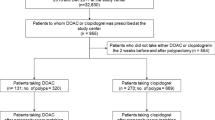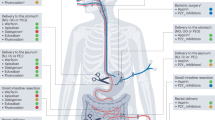Abstract
Over the past decade, the application of anticoagulant and antiplatelet agents for various cardiovascular and hematologic conditions has become more widespread. Optimal management of these agents during the periendoscopic period requires consideration, but limited prospective data mean that guidelines have largely relied on expert opinion. Elective procedures should be delayed in patients on temporary anticoagulation therapy (e.g. those with deep vein thrombosis). For procedures considered to have a low risk of bleeding (e.g. diagnostic endoscopy and colonoscopy without polypectomy) there is no need to discontinue or adjust anticoagulation. For procedures with a higher risk of bleeding (e.g. polypectomy and biliary sphincterotomy) an individual approach is required. This approach might include stopping oral anticoagulant therapy with or without the administration of unfractionated heparin or low-molecular-weight heparin for the preprocedure and postprocedure periods, during which the patient's international normalized ratio is in the subtherapeutic range.
Key Points
-
There are limited data to guide appropriate management of anticoagulation in the periendoscopic period
-
Low-bleeding-risk procedures can be performed without adjusting anticoagulation or antiplatelet therapy
-
High-bleeding-risk procedures might require cessation of oral anticoagulant therapy with the option of heparin bridging therapy, depending on the patient's thromboembolic risk
-
Although antiplatelet therapy can be withheld for high-bleeding-risk procedures, there is insufficient evidence to indicate that bleeding risk is impacted
-
Consultation with the patient's primary care physician, hematologist or cardiologist might be necessary to develop an optimal management strategy for complex cases
This is a preview of subscription content, access via your institution
Access options
Subscribe to this journal
Receive 12 print issues and online access
$209.00 per year
only $17.42 per issue
Buy this article
- Purchase on Springer Link
- Instant access to full article PDF
Prices may be subject to local taxes which are calculated during checkout

Similar content being viewed by others
References
Dupont WD and Plummer WD Jr (1998) Power and sample size calculations for studies involving linear regression. Control Clin Trials 19: 589–601
Eisen GM et al. (2002) Guideline on the management of anticoagulation and antiplatelet therapy for endoscopic procedures. Gastrointest Endosc 55: 775–779
Zuckerman MJ et al. (2005) ASGE guideline: the management of low-molecular-weight heparin and nonaspirin antiplatelet agents for endoscopic procedures. Gastrointest Endosc 61: 189–194
Thomopoulos KC et al. (2005) Acute upper gastrointestinal bleeding in patients on long-term oral anticoagulation therapy: endoscopic findings, clinical management and outcome. World J Gastroenterol 11: 1365–1368
Choudari CP et al. (1994) Acute gastrointestinal haemorrhage in anticoagulated patients: diagnoses and response to endoscopic treatment. Gut 35: 464–466
Kuwada SK et al. (1996) The risk of withdrawing chronic anticoagulation because of acute GI bleeding. Am J Gastroenterol 91: 1116–1119
Kearon C and Hirsh J (1997) Management of anticoagulation before and after elective surgery. N Engl J Med 336: 1506–1511
Cannegieter SC et al. (1994) Thromboembolic and bleeding complications in patients with mechanical heart valve prostheses. Circulation 89: 635–641
Stein PD et al. (2001) Antithrombotic therapy in patients with mechanical and biological prosthetic heart valves. Chest 119 (Suppl 1): S220–S227
Gage BF et al. (2001) Validation of clinical classification schemes for predicting stroke: results from the National Registry of Atrial Fibrillation. JAMA 285: 2864–2870
Singer DE et al. (2004) Antithrombotic therapy in atrial fibrillation: the Seventh ACCP Conference on Antithrombotic and Thrombolytic Therapy. Chest. 126 (Suppl 3): S429–S456
Ridker PM et al. (2003) Long-term, low-intensity warfarin therapy for the prevention of recurrent venous thromboembolism. N Engl J Med 348: 1425–1434
Palareti G and Legnani C (1996) Warfarin withdrawal. Pharmacokinetic-pharmacodynamic considerations. Clin Pharmacokinet 30: 300–313
Hutten BA and Prins MH . (2000) Duration of treatment with vitamin K antagonists in symptomatic venous thromboembolism. The Cochrane Database of Systematic Reviews, Issue 3, Art. No CD001367
Jaffer AK et al. (2003) When patients on warfarin need surgery. Cleve Clin J Med 70: 973–984
Prandoni P et al. (1996) The long-term clinical course of acute deep venous thrombosis. Ann Intern Med 125: 1–7
Anderson CS et al. (1994) Predicting survival for 1 year among different subtypes of stroke. Results from the Perth Community Stroke Study. Stroke 25: 1935–1944
Petty GW et al. (2000) Ischemic stroke subtypes: a population-based study of functional outcome, survival, and recurrence. Stroke 31: 1062–1068
Jorgensen HS et al. (1996) Acute stroke with atrial fibrillation. The Copenhagen Stroke Study. Stroke 27: 1765–1769
Gerson LB et al. (2000) Effect and outcomes of the ASGE guidelines on the periendoscopic management of patients who take anticoagulants. Am J Gastroenterol 95: 1717–1724
Blacker DJ et al. (2003) Stroke risk in anticoagulated patients with atrial fibrillation undergoing endoscopy. Neurology 61: 964–968
Waye JD et al. (1996) Complications of colonoscopy and flexible sigmoidoscopy. Gastrointest Endosc Clin N Am 6: 343–377
Nelson DB et al. (2002) Procedural success and complications of large-scale screening colonoscopy. Gastrointest Endosc 55: 307–314
Rosen L et al. (1993) Hemorrhage following colonoscopic polypectomy. Dis Colon Rectum 36: 1126–1131
Nivatvongs S (1986) Complications in colonoscopic polypectomy. An experience with 1,555 polypectomies. Dis Colon Rectum 29: 825–830
Ghazi A et al. (1984) Endoscopic gastroduodenal polypectomy. Ann Surg 200: 175–180
Muehldorfer SM et al. (2002) Diagnostic accuracy of forceps biopsy versus polypectomy for gastric polyps: a prospective multicentre study. Gut 50: 465–470
Freeman ML et al. (1999) Complications of endoscopic biliary sphincterotomy. N Engl J Med 335: 909–919
Cotton PB et al. (1991) Endoscopic sphincterotomy complications and their management: an attempt at consensus. Gastrointest Endosc 37: 383–393
Schapiro GD and Edmundowicz SA (1996) Complications of percutaneous endoscopic gastrostomy. Gastrointest Endosc Clin N Am 6: 409–422
Rutgeerts P et al. (1988) Palliative Nd:YAG laser therapy for cancer of the esophagus and gastroesophageal junction: impact on the quality of remaining life. Gastrointest Endosc 34: 87–90
Mathus-Vliegen EM and Tytgat GN (1986) Nd:YAG laser photocoagulation in colorectal adenoma. Evaluation of its safety, usefulness, and efficacy. Gastroenterology 90: 1865–1873
Affi A et al. (2001) Acute extraluminal hemorrhage associated with EUS-guided fine needle aspiration: frequency and clinical significance. Gastrointest Endosc 53: 221–225
Silvis SE et al. (1976) Endoscopic complications. Results of the 1974 American Society for Gastrointestinal Endoscopy Survey. JAMA 235: 928–930
Sorbi D et al. (2000) Postpolypectomy lower GI bleeding: descriptive analysis. Gastrointest Endosc 51: 690–696
Smith LE (1976) Fiberoptic colonoscopy: complications of colonoscopy and polypectomy. Dis Colon Rectum 19: 407–412
Hui AJ et al. (2004) Risk of colonoscopic polypectomy bleeding with anticoagulants and antiplatelet agents: analysis of 1,657 cases. Gastrointest Endosc 59: 44–48
Jafri SM (2004) Periprocedural thromboprophylaxis in patients receiving chronic anticoagulation therapy. Am Heart J 147: 3–15
Douketis JD et al. (2004) Low-molecular-weight heparin as bridging anticoagulation during interruption of warfarin. Arch Intern Med 164: 1319–1326
Dunn AS and Turpie AG (2003) Perioperative management of patients receiving oral anticoagulants: a systematic review. Arch Intern Med 163: 901–908
Shapira Y et al. (2002) Low-molecular-weight heparin for the treatment of patients with mechanical heart valves. Clin Cardiol 25: 323–327
Goldstein JL et al. (2001) Low molecular weight heparin versus unfractionated heparin in the colonoscopy peri-procedure period: a cost modeling study. Am J Gastroenterol 96: 2360–2366
Gerson LB et al. (2004) The management of anticoagulants in the periendoscopic period for patients with atrial fibrillation: a decision analysis. Am J Med 116: 451–459
Mathew A et al. (2003) Cost-saving approach to patients on long-term anticoagulation who need endoscopy: a decision analysis. Am J Gastroenterol 98: 1766–1776
Hui CK et al. (2002) Does withholding aspirin for one week reduce the risk of post-sphincterotomy bleeding? Aliment Pharmacol Ther 16: 929–936
Nakajima H et al. (1997) Aspirin effects on colonic mucosal bleeding: implications for colonic biopsy and polypectomy. Dis Colon Rectum 40: 1484–1488
O'Laughlin JC et al. (1981) Does aspirin prolong bleeding from gastric biopsies in man? Gastrointest Endosc 27: 1–5
Yousfi M et al. (2004) Postpolypectomy lower gastrointestinal bleeding: potential role of aspirin. Am J Gastroenterol 99: 1785–1789
Sharis PJ et al. (1998) The antiplatelet effects of ticlopidine and clopidogrel. Ann Intern Med 129: 394–405
Fork FT et al. (2000) Gastroduodenal tolerance of 75 mg clopidogrel versus 325 mg aspirin in healthy volunteers. A gastroscopic study. Scand J Gastroenterol 35: 464–469
Yusuf S et al. (2001) Effects of clopidogrel in addition to aspirin in patients with acute coronary syndromes without ST-segment elevation. N Engl J Med 345: 494–502
Diener HC et al. (1996) European Stroke Prevention Study 2: dipyridamole and acetylsalicylic acid in the secondary prevention of stroke. J Neurol Sci 143: 1–13
Author information
Authors and Affiliations
Corresponding authors
Ethics declarations
Competing interests
The authors declare no competing financial interests.
Rights and permissions
About this article
Cite this article
Makar, G., Ginsberg, G. Therapy Insight: approaching endoscopy in anticoagulated patients. Nat Rev Gastroenterol Hepatol 3, 43–52 (2006). https://doi.org/10.1038/ncpgasthep0387
Received:
Accepted:
Issue Date:
DOI: https://doi.org/10.1038/ncpgasthep0387
This article is cited by
-
Multicenter study on hemorrhagic risk of heparin bridging therapy for periendoscopic thromboprophylaxis
BMC Gastroenterology (2015)
-
Clinical management of esophagogastroduodenoscopy by clinicians under the former guidelines of the Japan Gastroenterological Endoscopy Society for patients taking anticoagulant and antiplatelet medications
Gastric Cancer (2014)
-
Risk of Bleeding After Percutaneous Endoscopic Gastrostomy (PEG)
Digestive Diseases and Sciences (2012)



